Department
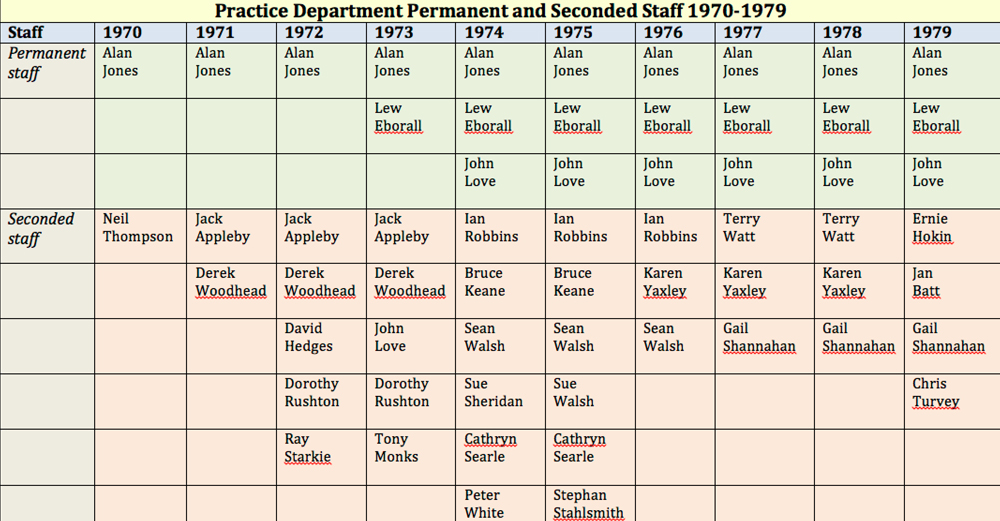 Unlike, other departments, the Prac department had a fluctuating staff population. This was largely due to the fact that MLTC was under the auspices of the Education Department of Western Australia, and therefore various teachers were seconded to this department for periods of 2-3 years. The constant in this arrangement, in the first four years, was Alan Jones, who was permanently assigned to MLTC.
Unlike, other departments, the Prac department had a fluctuating staff population. This was largely due to the fact that MLTC was under the auspices of the Education Department of Western Australia, and therefore various teachers were seconded to this department for periods of 2-3 years. The constant in this arrangement, in the first four years, was Alan Jones, who was permanently assigned to MLTC.
The use of seconded staff supplied a variety of highly experienced teachers, who excelled in teaching and could impart their skills to the students. This also advantaged the staff involved, as it allowed them to continue employment with the Education Department and apply for promotional opportunities at the same time. Seven years after the opening of MLTC, Terry Watt and Gail Shannahan, two of the original MLTC students were employed in this role.
Lew Eborall was appointed in 1973 and John Love in 1974, and both of these joined Alan Jones as permanent staff until at least 1979. Table 1 shows the various staff, who were seconded during the period from 1973-1979.
Programs
 In addition to running the pracs, staff in this area were also responsible for the school-based orientation week, which all first years attended. This was set up so students could observe real classroom activities and help teachers with their daily tasks. The school-based orientation allowed students to work within the school environment and experience the roles, tasks and daily activities of their chosen profession. This program was made possible, due to the earlier start of the primary school program and the later start of the College semester system.
In addition to running the pracs, staff in this area were also responsible for the school-based orientation week, which all first years attended. This was set up so students could observe real classroom activities and help teachers with their daily tasks. The school-based orientation allowed students to work within the school environment and experience the roles, tasks and daily activities of their chosen profession. This program was made possible, due to the earlier start of the primary school program and the later start of the College semester system.
Another area the Prac Department was involved with was teaching workshops, which were timetabled one morning per week. Teaching workshops comprised demonstration lessons in schools and micro-teaching with 3-4 children, peer group evaluation of video replays, group discussions and study of specific methods of instruction. These sessions enabled students to work through classroom problems. According to the MLTC Annual Report 11970, p.8 Section 4.8, prominence was given to using available aids and new educational techniques.
As stated previously, the Prac Department was responsible for teaching practice (preparation week) workshops. These were put in place to bridge the gap between theory and practice and enable the students to have the skills and confidence to teach a prac class.
These were based entirely on students’ individual needs, where they could approach any staff member for ideas, recommendations, approaches and methods related to their specific teaching tasks, as provided by their supervising teacher. On the first day of the week, students attended their allocated schools, obtained detailed school-specific briefings, met their classroom teacher, obtained lesson plans for expected lesson contents and to get a “feel” for the students and the general school environment.
The rest of the week, the students returned to College, where they were helped by Prac staff: to prepare and organize their lesson plans, teaching aids, audio-visual materials, and to develop presentation techniques. Students could borrow teaching aids, models, cameras and audio-visual devices from the resource centre, for use in their classroom. They could also participate in role playing activities to help build their repertoire of skills and provide confidence.
In the final year of the course, students were expected to undertake a 14 week assistant teachers program in the schools. Most of the organization and placement for the program was arranged by Lew Eborall and Alan Jones. They met with principals in the various primary schools to facilitate the program. This required considerable knowledge of identifying suitable schools, both for the quality of their teaching staff and programs, but also for the enthusiasm of the school principal and the supervisory skills of the selected supervising teachers.
As a result, school staff who participated in this, were extremely positive and enthusiastic about playing an important role in developing the skills and abilities of the students. In addition, they felt part of part of the MLTC program.
Both Alan Jones and Lew Eborall knew most of the principals and had an excellent rapport with them. Lew Eborall refined the content and organization of the third year practical teaching program annually. Despite the fact that Lew had never met a number of the students in the program, he always greeted the new students by name. They were very impressed by this!
Other activities within the Prac Department included: cross-graded team teaching (Belmay Primary School); teaching in remote schools and teaching for those with disability; and supervising children at camp schools (Pemberton, Point Peron).
Rural and Remote Schools
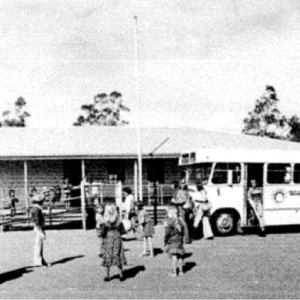 In the 1970s there only existed a single standardised course to prepare every student teacher for every classroom in Western Australia, regardless of context, location, demography or the particular needs and strengths of students.
In the 1970s there only existed a single standardised course to prepare every student teacher for every classroom in Western Australia, regardless of context, location, demography or the particular needs and strengths of students.
Early in 1973, two separate and serious complaints were brought by parents of graduates to Charles Staples, Acting Principal of the then Mount Lawley Teachers College (MLTC), claiming that the College had not adequately prepared these two graduates for their first teaching positions. One had been appointed to teach in a remote Aboriginal community and the other in the school in a town with a significant Aboriginal enrolment, both in the far north of WA.
As a result, students were required to undertake a rural or remote school placement, during their training, to ensure that they were adequately able to teach in these areas. They were introduced to multi-grade teaching and classroom organization. In 1974 the College and the Student Association conjointly acquired an old MTT bus. This bus became the means of transporting students to rural destinations , as well as College camps. It was also used to bring local children to the College for micro-teaching and other activities.
Permanent Staff
Alan Jones
…
Lew Eborall
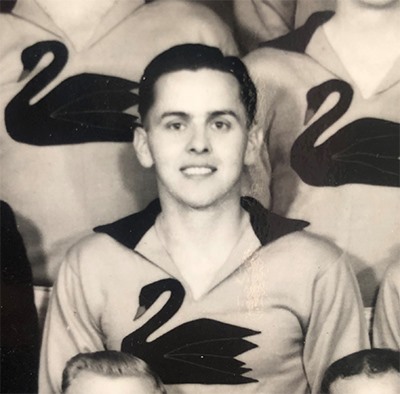
Vale Lew Eborall 6/5/1933 – 16/2/2020. Lew started played football in 1949 for the South Perth Metropolitan juniors before playing with the Teachers Training College in 1952.
He was a WAAFL State player in 1953, 1955, 1956 and 1958 and was selected in the All Australian Amateur Team in 1956. He was a WAAFL tribunal member from 1966 to 1986 and was elected a life member of the WAAFL in 1978. He was also an extremely valuable member of the MLTC Prac Department.
John Love
…
Seconded Staff
Neil Thompson
…
Jack Appleby
Jack Appleby – Interview by John Roberts, 6 December 1995
Derek Woodhead
…
David Hedges
…
Dorothy Rushton
…
Ray Starkie
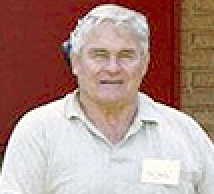
Tony Monks
…
Ian Robbins
When he requested Lake Grace as his first teaching appointment Ian Robbins began a 38 year career in education. He was born in Southhampton England and at the age of 12 his family migrated to Australia, having been sponsored by an uncle, Harry Fry. Soon after arriving Ian and his brother Mick were invited to Jack Lay’s farm in Lake Grace, and so started his love of the bush, especially this area. He often said that had he not been called to teaching, he
would have been farming around here.
He taught at the school from 1962-67 and was only 21 at the time. When we came to the school reunion a few years ago, he was so pleased to see that the Morrison which he had founded was still in existence. The attachment to the school was further strengthened when his daughter Dinah’s husband, Andrew Watt also had his first appointment there from ’87-’89. After Lake Grace Ian moved to a variety of different primary schools around Perth, and he also did some lecturing at Mt. Lawley Teachers’ College and at Curtin University.
In 1988 he was appointed Deputy Principal of Alinjarra Primary school in Alexander Heights, and he spent the last 13 years of his career there. An award has also
been created for a child at Alinjarra to receive the Ian Robbins Memorial Environment Award.
In the year before he died of cancer he received an Award of Recognition at Government House during Children‘s Week, for his positive contributions to the happiness and well-being of children. Alinjarra also honoured him by naming a nature trail which he had created at school The Ian Robbins Nature Trail.
Christine Robbins – 2004
Bruce Keane
Bruce Keane prepared a report for the Aboriginal Teacher Education Program (ATEP) at Mount Lawley College Department of Practical Teaching (The Keane Report, 1975). This was a collation of all past research plus information given by all Department and or persons experienced in Aboriginal Education.
The Keane Report investigated the feasibility of a proposal for a course for the training of Aboriginal Teacher Aides. While these proposals were not converted into active models, the report itself was the springboard into off-campus programs because the need for Aboriginal teachers was clearly identified, and the voices in remote communities were being heard.
Sean Walsh
Deceased 2012. Sean went on to become the Labor Ministerial Chief of Staff.
Warm and always funny memories of Sean at the Mill Street Coffee Shop, Mount Lawley Teachers College and the Geraldton Tennis Club.
Brian Haines – March 8, 2012
In fond memory of trusted, high performing Ministerial Chief of Staff and good friend to me, who went on to serve Ministers and Premiers in Labor Governments for over 20 years with diligence and unstinting loyalty. Sean’s native Irish humour and charm were the staple of his excellence in his favourite areas of tough negotiation and policy implementation and in his life as a whole. A humble achiever and one of the last of the True Believers who will be sadly missed. Deepest sympathy to Sue and his family who will miss him most of all.
Keith – March 2, 2012
Sean’s wry smile, twinkling eyes and great humour could light up a room. A wonderful raconteur; an engaging conversationist; and lifelong friend, he will be sadly missed.
Arthur and Helen Marshall – March 2, 2012
Sue Sheriden (Walsh)
Married to Sean Walsh
Cathryn Searle
…
Peter White
…
Stephan Stahlsmith
…
Terry Watt
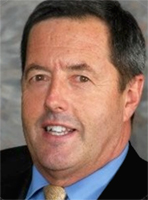 Terry was in the first intake of MLTC. He was interested in sport and physical eduction. He was the creator of the Kangaroo Street Gang series. These were created in 1981, through a set of reading books featuring a group of Australian bush animals
Terry was in the first intake of MLTC. He was interested in sport and physical eduction. He was the creator of the Kangaroo Street Gang series. These were created in 1981, through a set of reading books featuring a group of Australian bush animals
Karen Yaxley
…
Gail Shannahan
Former student
Ernie Hokin
…
Jan Batt
…
Chris Turvey
…
Margaret Parker-Jago
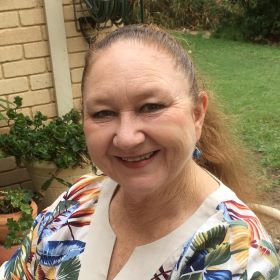 After graduating from Churchlands Teacher’s College in 1976, I was teaching at Warriapendi Primary School, when just four years out of college myself, I was approached and recommended for a secondment from the Department of Education, to work at Mt Lawley Teacher’s College for two years. To be offered a placement was a privilege, as it was recognition and acknowledgement of your outstanding teaching skills. The area in which I worked was called the Department of Practical Teaching, located in a demountable building at the edge of a limestone car-park at the back of the college, (not good for wearing fashionable high heels.) When it rained, it flooded and we nicknamed the car-park ‘Lake Mt Lawley’. The humble facilities always surprised me, as in actual fact, we were the vibrant hub of the college and dealt with every student on campus. My position was to lecture first year students on best practice of ‘how to deliver a good lesson’ and to supervise second and third year students on Practice. My favourite and very practical course was called T-Lab 100. We would lecture in small groups during the week and then once a week, the students had the enviable experience of visiting a school, to gain valuable hands-on experience and knowledge of the workings of a school and a classroom, prior to going on Practice for two weeks. This gave the students the edgy advantage over other colleges and universities and Mt Lawley gained a renowned reputation for its excellent teaching course.
After graduating from Churchlands Teacher’s College in 1976, I was teaching at Warriapendi Primary School, when just four years out of college myself, I was approached and recommended for a secondment from the Department of Education, to work at Mt Lawley Teacher’s College for two years. To be offered a placement was a privilege, as it was recognition and acknowledgement of your outstanding teaching skills. The area in which I worked was called the Department of Practical Teaching, located in a demountable building at the edge of a limestone car-park at the back of the college, (not good for wearing fashionable high heels.) When it rained, it flooded and we nicknamed the car-park ‘Lake Mt Lawley’. The humble facilities always surprised me, as in actual fact, we were the vibrant hub of the college and dealt with every student on campus. My position was to lecture first year students on best practice of ‘how to deliver a good lesson’ and to supervise second and third year students on Practice. My favourite and very practical course was called T-Lab 100. We would lecture in small groups during the week and then once a week, the students had the enviable experience of visiting a school, to gain valuable hands-on experience and knowledge of the workings of a school and a classroom, prior to going on Practice for two weeks. This gave the students the edgy advantage over other colleges and universities and Mt Lawley gained a renowned reputation for its excellent teaching course.
I had a wonderful boss named Alan Jones, Head of Department, full of good humour, character and mischief. He introduced me in the Staff Room, on my first day, and told my colleagues that I had my pilot’s licence and my underwater diving certificate, which was not true but made me sound interesting enough for everyone to want to talk to me and find out more. Some of my other colleagues were Lew Eborall, John Love and the Secretary Yvette Auckett. Sadly, they have all passed away but they were great mentors. I also worked with an exceptional colleague Debra (Rakich) Bull and we became life-long friends. I can honestly say that working at Mt Lawley Teacher’s College (MLTC), renamed the Western Australian College of Advanced Education (WACAE) in 1981, before Edith Cowan University (ECU) in 1991, were the best years of my teaching career. It was fun to go to work, share laughs, knowledge, go on camps, put on plays for the students and be responsible for supervising hundreds of students in schools around the metropolitan and country areas, on their Practice. We travelled to up to three schools in a day, so my navigational skills and driving improved. What a joy it was to glean from fellow practitioners! In those days, I only held an automatic driver’s licence and the fleet of college cars were all manual, so I was entrusted with Bob Peter’s, the Chancellor’s car, to use as my own. You should have seen the looks from people, with ‘who does she think she is?’, when I arrived at work and parked in the reserved bay at the front of the Administrative Office. From Mt Lawley, I worked within the Faculty of Education at Churchlands ECU doing sessional lecturing for third year students, marking papers for Bachelor of Education students, supervising student practices and managing to have three children of my own.
Over forty years of educating, I am currently still teaching at the grass roots level at Nedlands Primary School in Intervention, teaching English as an Additional Language/ Dialect (EAL/D) to newly arrived students from a variety of overseas countries. Nedlands has a very high percentage of EAL/D students and I thoroughly enjoy the diversity and multiculturalism of the school, where there is so much to learn from other cultures and languages, that makes the school an exciting environment in which to teach. During COVID-19 we were not greatly impacted and remained open with fewer numbers attending. It was a time of Zoom and Webex meetings, sending packages of work home and face to face contact made available. Some creative ideas were implemented for the students to do some practical activities at home without a device or worksheet. All bases were covered. Students were very good at social distancing, hand washing and sanitising. Parents kept their distance, extra cleaners were employed, life at school continued with limitations but generally uninterrupted. I am in awe of how professionally the pandemic was handled at school. COVID -19 taught us not to be complacent, stay connected and check in on people’s welfare and mental health.
Anyone enrolling in a teaching degree today needs to be prepared for flexibility, constant up-skilling with professional development, adaption to change, long hours (despite the general public thinking we get lots of holidays), sharing of ideas and collaboration, making appropriate modifications and adjustments for individuals, be resilient, highly organised, tolerant, reliable, persistent, be personable and communicative, engage in quality teaching and finally actually enjoy working with students. All these qualities are essential. Graduating students need to embrace the school in which they have been fortunate enough to gain a position, immerse themselves in the teaching culture, keep abreast of best practice and research in their chosen field and take every opportunity afforded them.
During the past decades, I have seen many changes from blackboards and chalk to interactive smart-boards, photocopiers replaced gestetners, iPads instead of pen and paper, laptops replaced workbooks and Integris replaced an attendance roll. I used to teach folk dancing, Health Hustles, sewing, photography and all the specialist areas of Physical Education, Sport, Music, Religion, Art and Craft, as well as all general subject areas of Mathematics, Reading, Writing, Science, Social Studies (now HaSS). I organised endless incursions and relied on the ABC television programs like ‘Behind the News’ and ‘Sing, Sing, Sing’. Mini- skirts were worn and smoking was allowed in the staff room. Can you imagine? Curriculum text books have changed, along with rights and responsibilities of the teacher, school administrations, promotions (we used to have a yearly Staff ‘stud’ Book with a number next to your name, to climb the ranks), teacher selection, school uniforms, reporting on-line, assemblies through Connect and meetings via Zoom. Schools now have an awareness of Aboriginal culture, Acknowledgement of Country and invite local Elders to school for Welcome to Country and smoking ceremonies. I have become more interested and connected to our Indigenous history, language, culture and stories and am excited to learn and share the Noongar language.
I am fortunate to be working at a school where students, parents and staff value education, students are self regulated and learning opportunities are enjoyable, varied and diverse. It never ceases to amaze me how quickly children adapt to their environment, the development of their language acquisition and how savvy they are with their use and knowledge of Technology. The care, respect and thoughtfulness they have for one another, truly restores my faith in teaching.
This article was written by Margaret Parker-Jago and compiled by Tim Flicker.